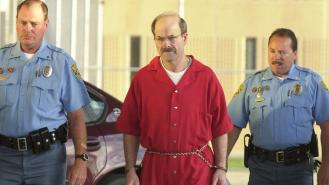
The criminology student turned killer: Stephen Griffiths 'The crossbow cannibal'
Between 2009 and 2010, three women inexplicably vanished in the city of Bradford, West Yorkshire, England. All three women were sex workers and when it was announced that the women had most likely fallen victim to foul play, a tremor of fear swept throughout the area. Memories of the Yorkshire Ripper came flooding back as police scrambled to identify the killer.
The first disappearance took place in June of 2009. 43-year-old Susan Rushworth was a mother of three and a grandmother who sold sex to fund her heroin addiction. She was last seen getting off a bus near the Tyke pub in Thornton Road, Bradford, on the 22nd of June, 2009 (Bradford Telegraph and Argus, 6 July, 2009 – ‘Plea for Help Over Missing Woman’). Her daughter, Kirsty, said: ‘Even though she used to take drugs and stuff, my friends always used to have a laugh with her and she’d give her right arm to anybody’ (Evening Standard, 28 May, 2010 – ‘Police Are Still Scouting City for Women’s Bodies’). At the time of Rushworth’s disappearance, she had been attempting to overcome her addictions and turn her life around and develop a relationship with her grandchildren.
There would be a respite until the following year when 31-year-old Shelley Armitage, who was described as a ‘much-loved daughter and sister’ vanished on the 26th of April, 2010. Armitage was a sex worker who had struggled with drug and alcohol dependency. She was captured on CCTV footage at around 10PM, walking along Rebecca Street in the red-light district, but her movements afterwards were unknown. A spokesman for Airedale and North Bradford CID would appeal for information: ‘Shelley has not been in touch with her boyfriend, friends or family since Monday and both they and the police are concerned for her welfare’ (Bradford Telegraph and Argus, 3 May, 2010 – ‘Police Plea Over Missing Shelley 31’).
Just the following month, another woman would vanish. 36-year-old Suzanne Blamires had been working the streets in the Allerton area when she disappeared on the 21st of May, 2010 (The Independent, 27 May, 2010 – ‘Murder of Three Prostitutes Sparks Fear of New “Ripper”’). Her mother, Nicky Blamires, described her daughter as ‘bright and articulate’ and said that she went to college and was training to become a nurse. ‘Unfortunately, my daughter went down the wrong path and she did not have the life she was meant to have,’ she said (The Independent, 29 May, 2010 – ‘I Am Crossbow Cannibal, Murder Suspect Tells Court’ ).
All three women were familiar faces in Bradford’s red-light district, which had been the haunt of the infamous Yorkshire Ripper in the 1970s. West Yorkshire Police would confirm in the media that they were investigating the three disappearances as murders, leading to fear within the community escalating, even more so in the red-light district area. One sex worker would state: ‘Everyone was really, really worried and scared. After Sue disappeared last year, everything had gone quiet but then suddenly Shell had gone as well. The girls were trying to keep safe’(Evening Standard, 27 May, 2010 – ‘Memories of Sutcliffe Come Back to Haunt Bradford’s Red-Light District’).
Towards the end of May 2010, a man was arrested in connection with the string of murders. He would be identified as a 40-year-old criminology student, Stephen Griffiths. His arrest had come the day after the dismembered remains of a woman were found in the River Aire and they were identified as Suzanne Blamires (The Independent, 28 May, 2010 – ‘The Addiction that Drives Women on to the Mean Streets of Bradford’). Griffiths had then been identified as a suspect when CCTV footage from his block of flats had captured him chasing Blamires down the hallway, attacking her and then shooting her with a crossbow (Evening Standard
Just the day after Griffiths was arrested, a member of the public found a rucksack in the River Aire at Shipley. Inside, they found a human head that was missing its skin, ears and nose. Embedded in the skull was a crossbow bolt and a broken knife. It was determined that the head belong to Blamires. Police divers would search further and find a portion of Armitage’s spine in the same stretch of river. They would also discover knives and hacksaws inside a small black flight bag around 250 yards away (The Times, 31 May, 2010 – ‘Hacksaws, Knives and Bones are Found in River’).
With Griffiths in custody, police announced that they were wanting to investigate whether Griffiths could have been involved in any other murders spanning back 20 years. In particular, they wanted to determine whether he could have been involved in the unsolved murders of three other women from the Bradford area which included Gemma Simpson, who vanished in 2000, 33-year-old Yvonne Fitt, who was stabbed to death in 1992, and 19-year-old Rebecca Hall, who was found beaten to death in a Bradford alley in 2001.
Griffiths had been born in Dewsbury and had spent three years at the £9,000 a year Queen Elizabeth Grammar School located in Wakefield after winning a place from the assisted places scheme. He was a psychology graduate doing a PhD in criminology at Bradford University. In 1987, after 17-year-old Griffiths was caught shoplifting from a supermarket, he turned on the manager and slashed him across the face with a craft knife. He would be convicted of wounding and sentenced to a three-year custodial sentence. According to his probation officer at the time, Griffiths had a ‘morbid fascination with knives’ and ‘saw himself as a murderer, but not until he reached his early 30s.’ When he was 21-years-old, he threatened to slash a girl’s throat and was convicted of affray and possession of an offensive weapon. He was sentenced to two years in jail (The Times, 22 December, 2010 – ‘He Was a Known Psychopath, Boasted of Sick Fantasies and was Free to Carry them out’). In 1991, a doctor said that he was a ‘sadistic, schizoid, psychopath.’
Back at his flat in Bradford, Griffiths mostly kept to himself and was known to be a loner who preferred to spend his time online than in the real world. He was an avid user of MySpace, where he had posted about notorious serial killers and proclaimed he was doing a ‘PhD in murder.’ He went under the pseudonym, Ven Pariah, and wrote that he was ‘the misanthrope who brought hate into heaven.’ During a search of his home, they found a plethora of books on serial killers as well as traces of blood of Rushworth, Armitage and Blamires.
Wanting to revel in his grisly actions, Griffiths would make a full confession to the three murders, telling police he had ‘killed loads.’ When asked how many, he held up six fingers. An examination Griffiths’ mobile phone would reveal that he had also filmed the body of Armitage as he gave a chilling running commentary. ‘I am Ven Pariah. I am the Bloodbath Artist. Here is a model who is assisting me,’ he said as he zoomed in to Armitage’s nude body in his bathtub. He told police that he had ‘sliced and diced’ the three women, killing Rushworth with a hammer and the other two with a crossbow. He even claimed that he had cannibalised portions of their flesh after roasting it. According to Griffiths, he ‘didn’t have much time for the human race’ (Huddersfield Daily Examiner, 4 October, 2020 – ‘The One Simple Mistake Which Ended the Crossbow Cannibal’s Killing Spree’).
Griffiths would appear in court to be charged with the murders of Rushworth, Armitage and Blamires. As he was asked to confirm his name, he chillingly responded: ‘The crossbow cannibal’. When asked for his address, he replied: ‘Here, I guess’ (Evening Standard, 28 May, 2010 – ‘Name? I’m Crossbow Cannibal’). Seven months later, he would plead guilty to the murders of Rushworth, Armitage and Blamires (Bradford Telegraph and Argus, 22 December, 2010 – ‘”Crossbow Cannibal”’ Stephen Griffiths Admits Three Murders’). He would be sentenced to life in prison with a whole life order meaning that he will most likely never be paroled. Behind bars, Griffiths has attempted suicide several times and has been the victim of numerous assaults. In 2019, he was stabbed in the chest by a fellow inmate.
Griffiths still refuses to divulge what he did with the body of Rushworth. Her son, James, would state that each anniversary of her death rekindled their despair at not being able to give her a proper burial.









